Global War on Terror - Air Force Cross
Listed below are the recipients of the Air Force Cross awarded for valor during the Global War on Terror which commenced in September of 2001 following the attack on the World Trade Center, the Pentagon, and an attempted attack on the White House.
* Indicates Killed in Action (KIA), Missing in Action (MIA), Prisoner of War (POW), or Died Non-Battle (DNB)
![]()
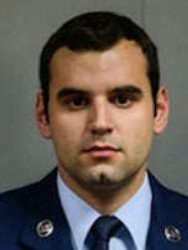

Citation:
The President of the United States of America, authorized by Title 10, Section 8742, United States Code, takes pleasure in presenting the Air Force Cross to Staff Sergeant Christopher G. Baradat, United States Air Force, for extraordinary heroism in military operations against an opposing armed force in Sono Valley, Sheltan District, Kunar Province, Afghanistan, on 6 April 2013. On that day, while attached to a United States Special Forces Team, Sergeant Baradat displayed extraordinary bravery and complete disregard for his own safety as he and his teammates responded as a quick reactionary force for a pinned down coalition element. Upon notification, Sergeant Baradat, his Special Forces Team and attached Afghan forces sprang into action entering the treacherous Sono Valley, a known sanctuary for Taliban and Al Qaeda militants. As Sergeant Baradat and his team moved through the tight valley on foot, they came under heavy enemy attack as they closed to within 800 meters of the pinned down element. Sergeant Baradat charged through a hail of enemy gunfire, engaging insurgent positions with 30-mm. gun runs from an A-10 aircraft before taking cover in a small compound with a handful of his teammates, approximately 400 meters from the pinned down element. Once in the compound, both ridgelines bordering the valley erupted in gunfire, attacking both Sergeant Baradat's location and that of the pinned down element. As he and his team hunkered down behind cover against the heavy onslaught of enemy firepower, Sergeant Baradat realized he could not effectively communicate with overhead aerial assets from his protected position. With complete disregard for his own safety, Sergeant Baradat moved to the center of the compound into direct enemy fire in order to communicate with orbiting aircraft. Ignoring repeated shouts from his teammate to take cover, over the next three hours Sergeant Baradat calmly directed lethal engagements from A-10 and AC-130 aircraft onto 13 enemy fighting positions consisting of over 100 fighters, while ignoring enemy machine gun rounds impacting all around him, spraying him with dirt. When all friendly forces consolidated and egressed the valley, Sergeant Baradat once again showed incredible bravery when he purposefully jumped onto the running board of the vehicle where he was continuously exposed to enemy fire so he could maintain communications. With rounds again impacting all around him, he continued to control AC-130 and A-10 strikes to destroy the enemy attempting to cut off the coalition forces. Sergeant Baradat's heroic and selfless actions directly resulted in over 50 enemy fighters killed, while saving the lives of over 150 friendly personnel. By his gallantry and devotion to duty, Sergeant Baradat has reflected great credit upon himself and the United States Air Force.
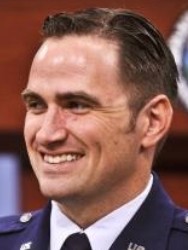

CRAWFORD, BARRY F.
Citation:
The President of the United States of America, authorized by Title 10, Section 8742, U.S.C., awarded the Air Force Cross to Captain Barry F. Crawford, Jr., for extraordinary heroism in military operations against an armed enemy of the United States as Special Tactics Officer of the 21st Special Tactics Squadron, in action near Laghman Province, Afghanistan, on 4 May 2010. On that date, while attached to Army Special Forces Operational Detachment Alpha and their Afghan partner force, Captain Crawford conducted a helicopter assault into Hendor Village. Upon landing, Captain Crawford received reports that multiple groups of armed enemy were maneuvering into prepared fighting positions in the high ground around the village. As the assault force initiated clearance operations, they began to receive a high volume of accurate machine gun and sniper fire from an enemy force well over 100 fighters. As the assault force was attacked, Captain Crawford took decisive action to save the lives of three wounded Afghan soldiers and evacuate two Afghan soldiers killed in action. Recognizing that the wounded Afghan soldiers would die without evacuation to definitive care, Captain Crawford took decisive action and ran out into the open in an effort to guide the helicopter to the landing zone. Once the pilot had eyes on his position, Captain Crawford remained exposed, despite having one of his radio antennas shot off mere inches form his face, while he vectored in the aircraft. Acting without hesitation, Captain Crawford then bounded across open terrain, engaged enemy positions with his assault rifle and called in AH-64 strafe attacks to defeat the ambush allowing the aid-and-litter teams to move toward the casualties. While the casualties were being moved the team's exposed position once again came under attack from two enemy trucks that had moved into the area and were threatening the medical evacuation landing zone. As one of the aid-and-litter teams was pinned down by enemy fire, and the medical evacuation helicopter took direct hits from small arms fire, it departed with only four casualties leaving one wounded Afghan soldier on the ground. Captain Crawford developed, coordinated, and executed a plan to suppress the enemy, enabling the helicopter to return to the hot landing zone to retrieve the last casualty. While Captain Crawford's element exfiltrated the village, the assault force conducted a two kilometer movement over steep terrain with little to no cover. During this movement the ground force commander and Captain Crawford's element were ambushed and pinned down in the open from multiple enemy fighting positions, some as close as 150 meters away. Without regard for his own life, Captain Crawford moved alone across open terrain in the kill zone to locate and engage enemy positions with his assault riffle while directing AH-64 30-mm. strafe attacks. Continuing to move the team further over 1.5 kilometers of steep terrain with minimal cover, Captain Crawford again engaged the enemy with his assault rifle while integrating AH-64s and F-15E's in a coordinated air-to-ground attack plan that included strafing runs along with 500 and 2,0000-pound bomb and Hellfire missile strikes. Throughout the course of the ten hour firefight, Captain Crawford braved effective enemy fire and consciously placed himself at grave risk on four occasions while controlling over 33 aircraft and more than 40 air strikes on a well-trained and well-prepared enemy force. His selfless actions and expert airpower employment neutralized a numerically superior enemy force and enabled friendly elements to exfiltrate the area without massive casualties. Through his extraordinary heroism, superb airmanship, and aggressiveness in the face of the enemy, Captain Crawford has reflected great credit upon himself and the United States Air Force.
![]()
![]()
![]()
![]()
![]()
![]()
![]()
![]()
![]()
![]()
![]()
![]()
![]()
![]()


Senior Airman, U.S. Air Force
For Services as Set Forth in the Following
Citation:
The President of the United States of America, authorized by Title 10, Section 8742, U.S.C., awards the Air Force Cross to Senior Airman Jason D. Cunningham for extraordinary heroism in military operations against an opposing armed force while serving as a pararescueman near the village of Marzak in the Paktia Province of Afghanistan on 4 March 2002. On that proud day, Airman Cunningham was the primary Air Force Combat Search and Rescue medic assigned to a Quick Reaction Force tasked to recover two American servicemen evading capture in austere terrain occupied by massed Al Qaida and Taliban forces. Shortly before landing, his MH-47E helicopter received accurate rocket-propelled grenade and small arms fire, severely disabling the aircraft and causing it to crash land. The assault force formed a hasty defense and immediately suffered three fatalities and five critical casualties. Despite effective enemy fire, and at great risk to his own life, Airman Cunningham remained in the burning fuselage of the aircraft in order to treat the wounded. As he moved his patients to a more secure location, mortar rounds began to impact within fifty feet of his position. Disregarding this extreme danger, he continued the movement and exposed himself to enemy fire on seven separate occasions. When the second casualty collection point was also compromised, in a display of uncommon valor and gallantry, Airman Cunningham braved an intense small arms and rocket-propelled grenade attack while repositioning the critically wounded to a third collection point. Even after he was mortally wounded and quickly deteriorating, he continued to direct patient movement and transferred care to another medic. In the end, his distinct efforts led to the successful delivery of ten gravely wounded Americans to life-saving medical treatment. Through his extraordinary heroism, superb airmanship, aggressiveness in the face of the enemy, and in the dedication of his service to his country, Senior Airman Cunningham reflected the highest credit upon himself and the United States Air Force.
![]()
![]()
![]()
![]()
![]()
![]()
![]()
![]()
![]()
![]()
![]()
![]()
![]()
![]()
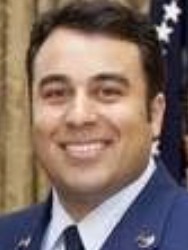

Citation:
The President of the United States of America, authorized by Title 10, Section 8742, United States Code, takes pleasure in presenting the Air Force Cross to Staff Sergeant Robert Gutierrez, Jr., United States Air Force, for extraordinary heroism in military operations against an armed enemy of the United States in Heart Province, Afghanistan, on 5 October 2009. On that date, while assigned as a combat controller of the 21st Special Tactics Squadron, to an Army Special Forces Detachment, Sergeant Gutierrez and his team conducted a high-risk nighttime raid to capture the number two Taliban leader in the region. During the initial assault, the team was attacked with a barrage of rifle and heavy machine-gun fire from a numerically superior and determined enemy force. Sergeant Gutierrez was shot in the chest, his team leader was shot in the leg, and the ten-man element was pinned down in a building with no escape route. In great pain and confronting the very real possibility that he would die, Sergeant Gutierrez seized the initiative and refused to relinquish his duties as joint terminal attack controller. Under intense fire, he engaged Taliban fighters with his M-4 rifle and brought airpower to bear, controlling three "danger close" A-10 strafing runs with exceptional precision against enemy forces just 30 feet away. After the first A-10 attack, the team medic performed a needle decompression to re-inflate Sergeant Gutierrez's collapsed lung, allowing him to direct the next two strafe runs which decimated the enemy force and allowed the team to escape the kill zone without additional casualties. Throughout the four-hour battle, Sergeant Gutierrez's valorous actions, at great risk to his own life, helped save the lives of his teammates and dealt a crushing blow to the regional Taliban network. Through his extraordinary heroism, superb airmanship, and aggressiveness in the face of the enemy, Sergeant Gutierrez reflected the highest credit upon himself and the United States Air Force.
HUNTER, RICHARD
Citation:
The President of the United States of America, authorized by Title 10, Section 8742, United States Code, takes pleasure in presenting the Air Force Cross to Staff Sergeant Richard B. Hunter, United States Air Force, for extraordinary heroism in military operations against an armed enemy of the United States as a Joint Terminal Attack Controller, 23d Expeditionary Special Tactics Squadron, Combined Joint Special Operations, Air Component-Afghanistan in Kunduz Province, Afghanistan from 2 November 2016 to 3 November 2016. During this period, while assigned to a Special Forces Team, Sergeant Hunter displayed extraordinary bravery as his team assaulted an insurgent safe haven. As they moved in a narrow alley, Taliban fighters ambushed them with grenade and heavy machine gun fire. With no regard for his own life, Sergeant Hunter placed himself between the enemy and his team, shielding the wounded with his body while providing suppressive fire with his rifle. To allow his team to withdraw from the kill zone, he positioned himself at the rear of the element, closest to the threat to prevent fratricide, and directed multiple danger-close airstrikes to within 20 meters; well inside the 190-meter danger-close distance for 105 millimeter rounds. With the team still under persistent enemy fire, Sergeant Hunter and four teammates cleared a compound to gain cover, preventing further casualties. Upon hearing a call for help, he again exposed himself to fire, rushing outside the compound to drag a wounded teammate 30 meters to safety. For the next two hours he controlled four AC-130U and AH-64D aircraft, continually directing fire on enemy positions, including 105 millimeter rounds to within 13 and 16 meters of his location. He courageously assumed greater risk by occupying the best vantage point to inflict devastating effect on the enemy, preventing the team from being overrun. During exfiltration, he called for airstrikes to suppress heavy enemy fire, he bravely exposed himself in a field during daylight to mark a landing zone with smoke. Throughout the eight hour assault, Sergeant Hunter alternated between firing his weapon at the enemy and controlling air assets, directing 1.787 munitions in 31 danger-close engagements, most to within 90 meters, resulting in 57 lives saved and 27 enemy killed. Through his extraordinary heroism, superb airmanship, and aggressiveness in the face of the enemy, Sergeant Hunter reflected great credit upon himself and the United States Air Force.
Home Town: Georgia
KELLER, DANIEL
Citation not yet available
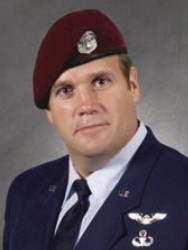

Citation:
The President of the United States of America, authorized by Title 10, Section 8742, United States Code, takes pleasure in presenting the Air Force Cross to Technical Sergeant Keary J. Miller, United States Air Force, for extraordinary heroism in military operations against an opposing armed force while serving with the 123d Special Tactics Squadron, during combat operations in support of Operation ENDURING FREEDOM, near Marzak, Patkia Province, Afghanistan, on 4 March 2002. On that proud date, Sergeant Miller was the Air Force Combat Search and Rescue Team Leader assigned to a Quick Reaction Force tasked to recover two American servicemen evading capture in austere terrain occupied by massed al Qaida and Taliban forces. Shortly before landing, his MH-47E helicopter received accurate rocket-propelled grenade and small arms fire, severely disabling the aircraft and causing it to crash land. Sergeant Miller and the remainder of the assault force formed a hasty defense and immediately suffered four fatalities and five critical casualties. Despite intense enemy fire, he moved throughout the battlefield, crossing open danger areas on numerous occasions, in order to assess and care for critically wounded servicemen. As the battle drew on, Sergeant Miller removed M-203 and 5.56 rounds from the deceased and, in multiple acts of extraordinary courage, proceeded through some of the day's heaviest rocket-propelled grenade, mortar, and small arms fire, while distributing the ammunition from position to position. Shortly thereafter another attack erupted, killing one Pararescueman and compromising the casualty collection point. Sergeant Miller braved the barrage of fire in order to move the wounded to better cover and concealment. His intrepidity and skill led to the successful delivery of ten gravely wounded Americans to life-saving medical treatment and to the recovery of seven servicemen killed in action. By his gallantry and devotion to duty, Sergeant Miller has reflected great credit upon himself and the United States Air Force.
Home Town: Maxwell, California
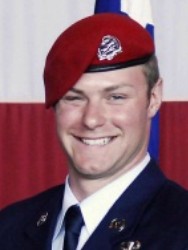

Citation:
The President of the United States of America, authorized by Title 10, Section 8742, United States Code, takes pleasure in presenting the Air Force Cross to Senior Airman Zachary J. Rhyner, United States Air Force, for extraordinary heroism in military operations against an armed enemy of the United States while serving with the 21st Special Tactics Squadron, at Nuristan Province, Afghanistan on 6 April 2008. On that date, while assigned as Special Tactics Combat Controller, Airman Rhyner executed a day rotary-wing infiltration with his Special Forces team to capture high-value insurgents in a village on the surrounding mountains. While climbing near vertical terrain to reach their objective, the team was attacked in a well-coordinated and deadly ambush. Devastating sniper, machine gun, and rocket-propelled grenade fire poured down on the team from elevated and protected positions on all sides, immediately pinning down the assault force. Without regard for his life, Airman Rhyner placed himself between the most immediate threats and provided suppressive fire with his M-4 rifle against enemy fire while fellow teammates were extracted from the line of fire. Airman Rhyner bravely withstood the hail of enemy fire to control eight United States Air Force fighters and four United States Army attack helicopters. Despite a gunshot wound to the left leg and being trapped on a 60-foot cliff under constant enemy fire, Airman Rhyner controlled more than 50 attack runs and repeatedly repelled the enemy with repeated danger close air strikes, several within 100 meters of his position. Twice, his actions prevented his element from being overrun during the intense 6 and a half hour battle. Through his extraordinary heroism, superb airmanship, and aggressiveness in the face of the enemy, Airman Rhyner reflected the highest credit upon himself and the United States Air Force.
Home Town: Medford, Wisconsin
RUIZ, IVAN
Citation:
The President of the United States of America, authorized by section 8742 of Title 10 U.S.C., takes pleasure in presenting the Air Force Cross to Master Sergeant Ivan M. Ruiz for extraordinary heroism in military operations against an armed enemy of the United States as a Pararescue Craftsman, 22 Expeditionary Special Tactics Squadron, Combined Joint Special Operations Air Component-Afghanistan, in Kandahar Province, Afghanistan, on 10 December 2013. On that date, Sergeant Ruiz attached to a team of Army Special Forces personnel and Afghan Commandos conducting a raid in denied terrain. After a point blank engagement with four insurgents, Sergeant Ruiz's team continued to clear a small compound of resistance while maneuvering towards neutralized insurgents to search their remains. Isolated from the 14 man element, Sergeant Ruiz and two teammates encountered a vicious insurgent crossfire, sweeping the courtyard with small arms fire and throwing hand grenades from barricaded strongpoints. Sergeant Ruiz eliminated one enemy fighter with well-aimed carbine fire, while enemy fire wounded his two comrades, rendering them immobile and exposed to enemy fire. Alone in the courtyard, Sergeant Ruiz completely disregarded his personal safety and refused to withdraw to cover. Single-handedly suppressing enemy fire until reinforcements arrived, Sergeant Ruiz pressed ahead under intense fire to reach his wounded comrades. Drawing fire from the enemy and returning fire to prevent the insurgents from maneuvering, he was gradually driven into a prone fighting position by the sheer volume of enemy fire. His refusal to leave the courtyard prevented enemy fighters from engaging his wounded teammates with direct fire weapons, though enemy grenades impacted within five meters of Sergeant Ruiz's position. Eventually joined by teammates, Sergeant Ruiz advanced through a hail of machine gun fire and grenades to drag a wounded teammate back to a position of relative cover and concealment. While still dangerously exposed to gunfire raking the compound, Sergeant Ruiz administered life-saving trauma care to his teammates while wearing night vision goggles. Sergeant Ruiz's heroic actions through intense enemy fire saved the lives of two teammates and contributed to eleven insurgents killed. Through his extraordinary heroism, superb airmanship, and aggressiveness in the face of the enemy, Sergeant Ruiz reflected the highest credit upon himself and the United States Air Force.
Home Town: Galloway, New Jersey
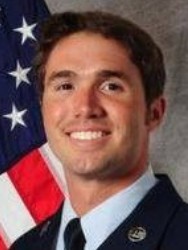

Citation:
The President of the United States of America, authorized by Title 10, Section 8742, U.S.C, awards the Air Force Cross to Senior Airman Dustin H. Temple for extraordinary heroism in military operations against an armed enemy of the United States while serving with the 21st Expeditionary Special Tactics Squadron in Helmand Province, Afghanistan from 27 to 29 September 2014. On these days, while attached to a United States Special Forces team, Airman Temple displayed extraordinary bravery and complete disregard for his own life as he and his teammates assaulted an insurgent safe haven. As overwhelming hostile fire continually suppressed his team, Airman Temple broke the assault on many occasions with danger close air support from F-16s, AH-1s, AC-130s and an MQ-1. Following a teammate being gravely wounded by a sniper, he put himself directly in the line of fire, and dragged his wounded teammate from the rooftop. With the evacuation helicopter inbound, Airman Temple again risked his own life to save his teammate, by carrying him across one hundred meters of open terrain. Despite overwhelming and accurate enemy machine gun fire, he remained on the open landing zone, providing covering fire while his teammates pulled back. After he returned to the compound, enemy fighters surged within 40 meters after intercepted communications stated, "Take the Americans alive." Airman Temple immediately directed F-16s in danger close strafing runs, killing one insurgent and repelling the assault. As supplies dwindled, he braved open terrain again to retrieve critical ammunition from a re-supply helicopter. With continuous machine gun fire, he and a teammate sprinted into the open and dragged the supplies off the aircraft; however, unable to carry the entire load, they withdrew back to cover. Airman Temple called in danger close fires from F-16s to cover his team as they went out to retrieve the remaining ammunition. Despite the continuous machine gun fire, Airman Temple and two teammates again ran into open terrain to retrieve the remainder of the supplies for a second time. At the end of the 48-hour engagement, he controlled 28 attack helicopters and 20 fixed wing assets for a total of 26 engagements while safely employing munitions at danger close range 75 times. Airman Temple's heroic and selfless actions directly resulted in confirmed 10 enemy fighters killed, and another eight estimated killed, while saving the lives of 38 friendly forces. Through his extraordinary heroism, superb Airmanship, and aggressiveness in the face of the enemy, Airman Temple has reflected the highest credit upon himself and the United States Air Force.
Home Town: Athens, Georgia

